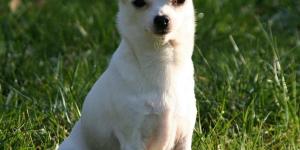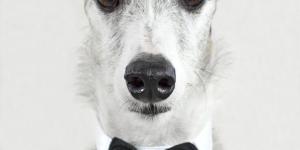Havanese Dog

The Havanese dog from the Bichon family, is an adorable small dog with long and soft hair. The origins of this breed lie between Spain and Italy but this breed eventually developed in Cuba where it coexisted with its aristocracy of the nineteenth century. It is a jovial, active and cheerful, dog, perfect for different families looking for a loving companion.
In this AnimalWised breed file we will discuss details about the character and care that a Havanese requires. If you are thinking of adopting one you have definitely come to the right place.
- Europe
- Italy
- Spain
- Group IX
- 5-14
- 14-18
- 18-22
- 22-27
- 27-31
- More than 31
- 2-7
- 7-22
- 22-55
- 55-100
- 100-220
History of a Havanese Bichon
This breed shares its origin with all the other bichons. Bichons descended from crosses of Barbet and lap dogs local to the Mediterranean coast. Other breeds which descend from that same bichon line are: Frise, Maltese, Bolognese and, phylogenetically, the poodle.
In the eighteenth and nineteenth centuries, Spanish sailors brought some of these bichons to Cuba, where they won the attention of Cuban aristocracy. At that time, these bichons were known as the "white bears from Havana," because they were exclusively white dogs.
It was only in the 19th century that the modern Havana bichon appeared, thanks to the contribution of German poodles. However, the breed lost popularity at the beginning of the 20th century and all the original Cuban lines disappeared, leaving the Havana bichon practically extinct. Fortunately, this breed was rescued by Cuban breeders in the United States.
According to the International Cynological Federation (FCI), the name of Havanese does not come from the development of the breed in Havana. ‘Habono’ is Spanish for the predominant tan brown color of the modern Havanese breed.
Characteristics of a Havanese
The body of this dog is small and slightly longer than its height. Its upper line is straight, but arches slightly on the back and its rump is inclined. Its lower line has a well-tightened belly.
The head of the havanese is broad with a flattened or slightly convex top. Its nose is black or brown. Its eyes, carrying a friendly expression, are large, almond shaped and dark brown. The ears of this dog are of high insertion and fall to the sides of its cheeks, its end forms a little pointed tip.
It has a curved shaped tail preferably rolled on the back. It has a characteristic fringe with long silky hairs.
As in other Bichons, the coat of the havanese has either a single layer or a very underdeveloped inner layer of fur. Its covering mantle is between 12 and 18 centimeters long with soft, straight or wavy hair. According to the standard of the International Cynological Federation (FCI), this breed can appear in different shades of black, brown, tobacco or reddish brown. Fur stains in this breed are also common. The FCI standard does not indicate an ideal weight for this breed, but the height at the withers ranges from 23 to 27 centimeters.
Character of a Havanese
In general, these dogs are very playful, active, vivacious and even a little silly. As they are happy and sociable, they need a lot of company and a lot of mental stimulation.
Havanese tend to be sociable with people, dogs and other animals. In addition, despite their small size, they are usually very friendly with children. However, they can be aggressive or timid when have they received poor socialization training. Therefore, it is important to socialize these dogs from when they are puppies.
These dogs are very intelligent and easy to train. These dogs used to work in circuses, but fortunately, this is no longer the case. These dogs respond well to all types of training, including: competitive , freestyle and agility training. These dogs react the very well to positive reinforcement training, such as clicker training.
Havanese are prone to some behavioral problems such as: excessive barking, separation anxiety and the object destruction. These problems, however, will only occur if the dog does not receive appropriate exercise, time or training that it requires.
These dogs are perfect for families with/without children or first time owners.
Caring for a Havanese
This dog’s hair is prone to knots and tangles therefore it is necessary to brush and comb it at least every other day. However, and unlike many breeds of longhaired dogs, the havanese does not need a canine hairdresser. They should only be bathed when they are dirty and should not be bathed frequently. The havanese bichon is a hypoallergenic dog, therefore they do not lose hair easily.
A havanese requires moderate exercise consisting of daily walks, games or obedience training. These dogs are also known to love swimming. If your havanese is going to swim, it is important to make sure that this is done in a safe place.
In any case, due to their size, havanese can exercise at home. They adapt very well to life in an apartment or densely populated cities.
These dogs require a lot of company. They need to be constantly accompanied and should not live isolated in a yard or garden. These dogs are not suited to being left alone all day as they can suffer from depression or separation anxiety.
Educating a Havanese
As with all dogs, in his puppy stage, a havanese puppy needs to follow a socialization process that allows it to learn to interact with other dogs, pets, children, adults and objects. The purpose of socialization is to avoid the emergence of future behavior problems as a result of fear. However, if a havanese is in a new and uncomfortable environment, trained or not, it is normal that it will sense slight fear.
A havanese is incredibly intelligent therefore training this dog is easy. As mentioned before, this dog responds incredibly well to positive reinforcement, such as clicker training. This positive reinforcement will not only end in good results, but it will also create a great relationship between you and your dog.
Health of a Havanese
Havanese are generally healthy. However, like all dogs, they can sometimes present tendencies towards some canine diseases. Patellar dislocation is perhaps the most frequent disease noted the breed. Other common diseases, although not as frequent as the previous one, are;
- progressive atrophy of the retina
- cataracts
- otitis externa
Havanese Dog photos


















